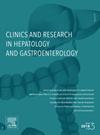儿童和青少年代谢功能障碍相关脂肪变性肝病(MASLD)的治疗方式:随机对照试验的系统回顾和荟萃分析
IF 2.4
4区 医学
Q2 GASTROENTEROLOGY & HEPATOLOGY
Clinics and research in hepatology and gastroenterology
Pub Date : 2025-09-09
DOI:10.1016/j.clinre.2025.102685
引用次数: 0
摘要
简介:代谢功能障碍相关的脂肪变性肝病(MASLD)在儿童和青少年中普遍存在。尽管发病率较高,但该人群的有效治疗方案仍存在争议。本荟萃分析旨在评估所有可用于MASLD的非侵入性治疗方式的效果。方法:本研究包括PubMed、Cochrane Library和Embase检索(2010年1月至2025年7月)的随机对照试验(RCTs),评估儿科和青少年MASLD的不同治疗方式。使用Cochrane Risk of bias 2工具评估偏倚风险。主要指标为天冬氨酸转氨酶(AST)、甘油三酯(tg)和低密度脂蛋白(LDL)。次要指标为谷氨酰基转移酶(ALT)、谷氨酰基转移酶(GGT)、高密度脂蛋白(HDL)及不良反应。数据分析采用Revman 5.3软件。使用标准平均差(SMD)汇总连续值。进行敏感性分析以减少异质性。本研究注册号为PROSPERO, CRD42024596682。结果:我们纳入31项随机对照试验,共1722名受试者。确定了多种治疗方式,并将其分为饮食干预、补充、药物干预和运动。我们进一步将饮食干预分为低糖饮食、低脂饮食和地中海饮食,并与不同的对照组进行比较。低糖饮食与安慰剂/常规饮食相比,TG水平有显著改善[-2.44,95%CI: -3.61,-1.27], AST水平与低脂饮食相比有显著改善[-1.02,95%CI: -1.88, -0.16]。与安慰剂相比,给予益生菌组LDL水平有显著变化[-0.33,95% CI: -0.65,0.00]。结论:补充剂和饮食干预可改善肝酶和血脂。然而,需要更多的研究来评估与这些干预措施相关的剂量和不良反应。本文章由计算机程序翻译,如有差异,请以英文原文为准。
Treatment modalities for metabolic dysfunction-associated steatotic liver disease (MASLD) in children and adolescent: A systematic review and meta-analysis of randomized controlled trials
Introduction
Metabolic dysfunction-associated Steatotic Liver Disease (MASLD) is prevalent amongst children and adolescents. Despite higher incidence, effective treatment options for this population are controversial. This Meta-analysis aims to evaluate the effects of all non-invasive treatment modalities available for MASLD.
Methods
This study includes PubMed, Cochrane Library, and Embase searches (January 2010 to July 2025) for Randomised Controlled Trials (RCTs), evaluating different treatment modalities of MASLD in pediatrics and adolescent population. Risk of bias was assessed using the Cochrane Risk of Bias 2 tool. Primary outcomes were Aspartate Aminotransferase (AST), Triglycerides (TGs) and Low-Density Lipoproteins (LDL). Secondary outcomes were Alanine Aminotransferase (ALT), Gamma-Glutamyl Transferase (GGT), High-Density Lipoprotein (HDL) and adverse effects. Data were analyzed using Revman 5.3. Continuous values were pooled using the standard mean difference (SMD). Sensitivity analysis was performed to reduce heterogeneity. This study was registered with PROSPERO, CRD42024596682.
Results
We included 31 RCTs, having 1722 participants. Multiple treatment modalities were identified and categorized into dietary intervention, supplementation, drug intervention and exercise. We further categorized dietary intervention into low-sugar diet, low-fat diet and mediterranean diet and compared against different controls. The low-sugar diet showed significant improvement in TG levels against placebo/usual diet [-2.44,95 %CI:3.61,-1.27] and in AST levels against low-fat diet [-1.02, 95 %CI –1.88, -0.16]. LDL levels showed significant change when probiotics were administered against placebo [-0.33, 95 % CI:0.65,0.00].
Conclusion
Supplements and Dietary intervention have shown improvement in liver enzymes and lipid profile. However, more research is required to evaluate the dosage and adverse effects associated with these interventions.
求助全文
通过发布文献求助,成功后即可免费获取论文全文。
去求助
来源期刊

Clinics and research in hepatology and gastroenterology
GASTROENTEROLOGY & HEPATOLOGY-
CiteScore
4.30
自引率
3.70%
发文量
198
审稿时长
42 days
期刊介绍:
Clinics and Research in Hepatology and Gastroenterology publishes high-quality original research papers in the field of hepatology and gastroenterology. The editors put the accent on rapid communication of new research and clinical developments and so called "hot topic" issues. Following a clear Editorial line, besides original articles and case reports, each issue features editorials, commentaries and reviews. The journal encourages research and discussion between all those involved in the specialty on an international level. All articles are peer reviewed by international experts, the articles in press are online and indexed in the international databases (Current Contents, Pubmed, Scopus, Science Direct).
Clinics and Research in Hepatology and Gastroenterology is a subscription journal (with optional open access), which allows you to publish your research without any cost to you (unless you proactively chose the open access option). Your article will be available to all researchers around the globe whose institution has a subscription to the journal.
 求助内容:
求助内容: 应助结果提醒方式:
应助结果提醒方式:


